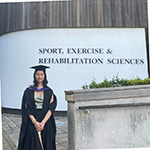What is a migraine?
A migraine is a neurological condition that causes an individual to experience painful headaches. Migraines are commonly only felt on one side of the head and cause individuals to experience both pulsing and throbbing pains. Brain Research UK states that migraines are one of the most common neurological disorders, with further statistics indicating that 10% of the global population suffer from migraines.1, 2 But what exactly is a migraine? And most importantly, how do we make those debilitating headaches go away?
Types of migraine
Migraines are categorised by the symptoms in which the individual suffers during both the build up to and during the migraine attack. Whilst there are many subcategories a migraine can fall into, there are two main types of migraine: with aura and without aura.
Migraine with Aura
An ‘aura’ refers to the sensory changes that are experienced in the build up to a migraine attack. Therefore, a migraine with aura is simply a migraine that occurs after one or several clear warning signs. Examples of these warning signs differ from person to person, with some individuals suffering from nauseousness, seeing flashing lights, and/or neck pain/stiffness.
Migraine without Aura
The American Migraine Foundation reports that migraines without aura are the most common type of migraine, with further research finding 80% of migraines occur without aura.3, 4 A migraine without aura refers to a migraine that occurs without any warning signs, as well as experiencing a severe pulsing sensation on one side of the head. Additionally, vomiting and becoming extremely sensitive to light and sound are common in those who experience migraines without aura.
Causes
The primary cause of migraines is still unknown. However, research indicates that it could be due to periods of abnormal brain activity temporarily affecting the nerve signals, blood vessels, and chemicals found within the migraine sufferer’s brain. Whilst the definitive cause of migraines remains unknown, some of the common migraine triggers are well documented. Examples include:
- Stress
- Intense physical activity
- Changes in the weather
- Changes in sleeping patterns
- Skipping meals
- Prolonged time staring at a computer/phone screen
- Dehydration
- Teeth grinding or muscle tension
Symptoms
The most notable symptom of a migraine is a severe pulsing or throbbing sensation experienced in one side of the head that commonly gets progressively worse when trying to perform any sort of task that involves movement or concentration. In most cases, those with a migraine will experience symptoms for anywhere between four hours and three days. Whilst pain is most commonly experienced on one side of the head, some sufferers of migraines experience pain on both sides of their head, as well as in their neck and face. Additional symptoms include:
- Feeling nauseous
- Vomiting
- Changes in body temperature
- Sweating
- Sensitivity to light
- Difficulty concentrating
- Diarrhoea
- Stomach pains
Diagnosis
Unlike most medical conditions, there is no specific test or scan that can be done to diagnose an individual with migraine. Instead, medical professionals will utilise an individual’s medical history, symptoms, and triggers to determine their condition. Here is what to expect when visiting your local GP regarding a migraine.
Questions: GPs will likely ask a variety of questions regarding your symptoms, for example, where you experience the pain and if you suffer from any additional symptoms (e.g. vomiting, partial sight loss, or dizziness).
Migraine Diary: To help deepen the GP’s understanding of your condition, you may be asked to record your migraines in a migraine diary for a few weeks. If you are asked to do so, ensure to record the following:
- The date you suffered the migraine
- The time you suffered the migraine
- How long did the migraine last
- The symptoms you experienced before and during
- What were you doing when you first experienced symptoms
- Did you take any medication? If so, what medication did you take and did it alleviate pain?
Specialist Referral: If your GP is unable to definitively diagnose you, you may be referred to a neurologist for further examinations. You may also be referred to a neurologist if your migraine diary identifies you have a chronic migraine, a condition that causes migraine attacks to occur at least 15 times a month. You also may be referred to a specialist if the treatment you are prescribed does not help reduce the severity of your symptoms.
Treatment
Unfortunately, medical professionals are yet to find a way to cure migraines. However, there are a range of medications and remedies that can at least help those with the condition reduce their symptoms.
Medications
For most individuals suffering from migraines, taking a specific medication or a combination of medications can help reduce the severity of the symptoms suffered during a migraine attack. It is, however, important to note that you should always discuss with your GP about which medication is best for your condition before taking it. They will be able to advise you on this and provide information on any of the possible side effects that may occur as a result of taking the medication.
Painkillers: Painkillers, such as aspirin, ibuprofen and paracetamol, have been shown to be an effective way of soothing migraine symptoms, provided you take them as soon as the first symptoms begin. For those who are regularly ill whilst suffering from migraines or cannot swallow tablets, pain killers can be taken via dissolvable tablets or suppositories.
Anti-Sickness Medicines: These most often come in the form of a tablet, and once again should be taken as soon as the symptoms of the migraine begin. Research has found that anti-sickness medicines can help reduce vomiting and the feeling of nauseousness, as well as reduce the overall severity of the migraine.5
Triptans: Triptans are commonly prescribed to patients whose symptoms are not relieved when taking standard painkillers. Triptans are normally taken alongside painkillers and anti-sickness medication and can be injected, taken in tablet form or via nasal spray. They help reduce blood flow to the brain, thus, reducing pressure and head pain.6
Combination of Medicines: Medicines that contain both painkillers and anti-sickness medication can be purchased from local pharmacies. Whilst this is extremely convenient, some find the dosage of painkiller and anti-sickness medication within combination medicines are not high enough, meaning it does not completely soothe their symptoms.
Non-medical remedies to handle migraines
Alongside their medication, many migraine sufferers find that a combination of non-medical remedies can help soothe their condition. Here is a list of some of the non-medical methods that have proved most effective:
Dim the Lights and Avoid Screen Glare: Many migraine sufferers find that sitting in the dark for 20 to 30 minutes helps suppress the severity of their migraine. Scientists believe 20 to 30 minutes is how long it takes the light sensitive cells that are active during a migraine to become less active, thus subsiding the pain.8
Apply Cold Pack or Hot Compress: Like many conditions that cause pain, applying a hot or cold compress can help relieve migraine symptoms. Applying a cold compress helps numb migraine pain whereas applying heat helps relax tense muscles, thus alleviating tension and pain.
Acupuncture: Research has found that acupuncture can be extremely beneficial in reducing the number of migraine attacks sufferers of the condition experience.7 Acupuncture involves inserting needles into pressure points around the body. It has been shown to stimulate our circulatory and nervous system, releasing endorphins and other hormones, reportedly helping reduce migraines and tension headaches.
Drink Caffeine: Whilst too much caffeine can trigger headaches, studies have found that a small dose (~ 130mg) of caffeine can actually reduce the amount of pain migraine sufferers experience.9 Caffeine causes our blood vessels to narrow, reducing blood flow to the brain which in turn reduces the pain experienced in headaches.
Eat Healthy Foods: Those who regularly suffer migraines should look to consume a balanced and healthy diet, paying particular attention to the amount of magnesium and omega-3 fatty acids they consume. Regular consumption of both has been shown to reduce the severity of the symptoms experienced by migraine sufferers.10
Eat ginger: Whilst further studies are required to fully understand how and why, research has found that consumption of ginger can help reduce both the pain and feeling of nauseousness suffered during a migraine attack.11
Regular Exercise: Research indicates that performing regular aerobic exercises, such as walking, jogging, and cycling, can reduce the number of monthly migraine attacks those with the condition suffer from.12 Exercise also causes our body to produce pain-relieving endorphins, meaning in some cases physical activity can help reduce the severity of pain experienced during a migraine attack.
Head Massage: Receiving a head massage is an effective way of reducing the severity of pain experienced during a migraine attack. The correct method for a head massage is fairly simple and can be done by yourself if there is no one around to do it for you. Sit down in a comfortable chair and begin to move your fingers or massage tool around your head, performing circular motions whilst applying light pressure. Do so for 5 minutes, making sure to cover your whole head.
Aromatherapy: Aromatherapy is a type of massage that utilises warm essential oils, such as lavender and chamomile oil. Essential oils appear to be an effective tool for those who regularly suffer migraines, with studies finding they can reduce the severity and frequency of migraine attacks.13
Avoid Teeth Grinding or Excessive Chewing: Whilst a habit many of us fall into, grinding our teeth and excessive chewing can actually trigger tension headaches and migraines. Chewing/grinding creates pressure that can spread from our jaw into the rest of the skull, causing tension to build up and triggering tension headaches.
Managing Stress: Stress is one of the most common triggers for migraines.14 How we manage our stress can differ greatly from person to person. Finding the most effective daily routine and relaxation techniques can take time but it can be extremely beneficial for those looking to decrease the frequency and severity of their migraines. Below are some of the most effective stress management and relaxation techniques.
- Breathing techniques
- Regular exercise
- Healthy diet
- Consistent sleep pattern
- Set yourself realistic goals and targets
- Head massage
- Relaxing music
- Yoga
- Meditation
When to see a doctor
You should book an appointment with your local GP if you regularly experience more than 5 migraines a month. An appointment with your local GP should also be booked if you experience a migraine that lasts longer than 72 hours or your headaches become extremely painful. Furthermore, it is recommended you visit your local GP if you experience symptoms, such as vomiting, alongside your head pains.
Whilst extremely rare, very severe migraines can have long-term health implications and can even be fatal without medical attention. If you or someone in your vicinity suffers from any of the following symptoms, ensure to call 999 immediately.
- Loss of movement on one side of the body
- One side of the body feels weaker
- Extreme headache like pain
- Full or partial loss of vision/ double vision
- Slurred words
- High temperature
Summary
Migraines can be an extremely debilitating condition that makes performing even the simplest daily tasks difficult. If you regularly experience some of the aforementioned migraine symptoms, ensure to book an appointment with your local GP as soon as possible. By discussing your symptoms with your GP, you will sooner be able to combat your symptoms with the correct medication and lifestyle changes, helping you reduce the severity and frequency of your migraine attacks.
References
- Migraine – Neurological Condition. https://www.brainresearchuk.org.uk/neurological-conditions/migraine
- Walter, Kristin. ‘What Is Migraine?’ JAMA, vol. 327, no. 1, Jan. 2022, p. 93. Silverchair, https://doi.org/10.1001/jama.2021.21857
- ‘Migraine Without Aura’. American Migraine Foundation, https://americanmigrainefoundation.org/resource-library/migraine-without-aura/
- Migraine without Aura - an Overview | ScienceDirect Topics. https://www.sciencedirect.com/topics/medicine-and-dentistry/migraine-without-aura#:~:text=Eighty%20percent%20of%20migraines%20have,bilateral%20in%2040%25%20of%20cases
- Láinez, Miguel JA, et al. ‘Optimal Management of Severe Nausea and Vomiting in Migraine: Improving Patient Outcomes’. Patient Related Outcome Measures, vol. 4, Oct. 2013, pp. 61–73. PubMed Central, https://doi.org/10.2147/PROM.S31392
- Encyclopedia of Food Sciences and Nutrition | ScienceDirect. https://www.sciencedirect.com/referencework/9780122270550/encyclopedia-of-food-sciences-and-nutrition
- Xu, Shabei, et al. ‘Manual Acupuncture versus Sham Acupuncture and Usual Care for Prophylaxis of Episodic Migraine without Aura: Multicentre, Randomised Clinical Trial’. BMJ, vol. 368, Mar. 2020, p. m697. www.bmj.com, https://doi.org/10.1136/bmj.m697
- ‘What Is Photophobia as It Relates to Migraine? Can It Be Treated?’ American Migraine Foundation, https://americanmigrainefoundation.org/resource-library/what-is-photophobia/
- Nowaczewska, Magdalena, et al. ‘The Ambiguous Role of Caffeine in Migraine Headache: From Trigger to Treatment’. Nutrients, vol. 12, no. 8, July 2020, p. 2259. PubMed Central, https://doi.org/10.3390/nu12082259
- Meng, Shu-Han, et al. ‘Dietary Intake of Calcium and Magnesium in Relation to Severe Headache or Migraine’. Frontiers in Nutrition, vol. 8, Mar. 2021, p. 653765. PubMed Central, https://doi.org/10.3389/fnut.2021.653765
- Andrade, Chittaranjan. ‘Ginger for Migraine’. The Journal of Clinical Psychiatry, vol. 82, no. 6, Nov. 2021, p. 21f14325. PubMed, https://doi.org/10.4088/JCP.21f14325
- Lemmens, Joris, et al. ‘The Effect of Aerobic Exercise on the Number of Migraine Days, Duration and Pain Intensity in Migraine: A Systematic Literature Review and Meta-Analysis’. The Journal of Headache and Pain, vol. 20, no. 1, Feb. 2019, p. 16. BioMed Central, https://doi.org/10.1186/s10194-019-0961-8
- Ahmadifard, Mahdieh, et al. ‘The Efficacy of Topical Basil Essential Oil on Relieving Migraine Headaches: A Randomized Triple-Blind Study’. Complementary Medicine Research, vol. 27, no. 5, 2020, pp. 310–18. PubMed, https://doi.org/10.1159/00050634914. Sauro, Khara M., and Werner J. Becker. ‘The Stress and Migraine Interaction’. Headache, vol. 49, no. 9, Oct. 2009, pp. 1378–86. PubMed, https://doi.org/10.1111/j.1526-4610.2009.01486.x

 1st Revision: Anna-Mazepa
1st Revision: Anna-Mazepa  2nd Revision: Jasmine Yeh
2nd Revision: Jasmine Yeh 3rd Revision: Pranitha Ven Murali
3rd Revision: Pranitha Ven Murali




